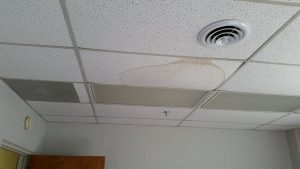There are lots of news stories in our area and I am sure more to come as flood waters go back down. We have had a very wet year. There are basements flooding that have never gotten water in them before. This is leading to stories about black stuff growing on walls. I am hearing it more and more, Help, I might have a mold problem in my home.

Molds can be found almost anywhere and can grow on most organic substances. They just need a moist area, a little oxygen, and it loves dark spaces. There are many types of mold and I have no basis to discuss which are toxic and which are not. We all react differently to different molds. It is also impossible to stop all mold and mold spores from existing in your indoor living environment. The goal should not be mold clean-up, it should be controlling moisture in your space to prevent growth – then clean-up.

Most mold growth will occur from specific conditions – flood, roof leak, high humidity inside (unvented combustion appliances will encourage it), deferred maintenance, stagnant air, vented crawl spaces, leaks in duct work that is not insulated well, wrong sized HVAC systems, and almost always lack of proper ventilation. When mold growth happens in a space it can have health impacts on those occupying the space. However, it is very hard to tie health problems to a specific space, again, mold exists everywhere.
Some tips for clean-up that need to be followed after a moisture event are as follows:
- Anything that has gotten wet needs to be dried within 24 – 48 hours, completely dried, or it should be removed not just cleaned.
- Dehumidification should be used to keep humidity levels below 50% to dry out porous materials.
- You should isolate the spaces while they are being cleaned to prevent cross contamination.
- HVAC systems should not be operating during clean up.
- Duct work should be cleaned as well as coils on the HVAC (the only EPA endorsed way to clean HVAC units that are contaminated is removal and replacement).
- Proper ventilation should be installed and controlled by the HVAC system.
Cleanup recommendations from the EPA
The purpose of mold remediation is to remove the mold to prevent human exposure and damage to building materials and furnishings. It is necessary to clean up mold contamination, not just to kill the mold. Dead mold is still allergenic, and some dead molds are potentially toxic. The use of a biocide, such as chlorine bleach, is not recommended as a routine practice during mold remediation, although there may be instances where professional judgment may indicate its use (for example, when immune-compromised individuals are present). In most cases, it is not possible or desirable to sterilize an area; a background level of mold spores will remain in the air (roughly equivalent to or lower than the level in outside air). These spores will not grow if the moisture problem in the building has been resolved.

So, as you are working on cleaning up an area that has black stuff growing (again, I cannot tell you anything about mold so I will just say black stuff) make sure to take the proper health precautions during clean-up. Follow guidelines for removal of wet porous surfaces that are not dried completely quickly. Fix the cause of the problem, don’t just clean up the symptoms.




